Chewing the cud is an adaptation peculiar to?
- A. Herbivores
- B. Omnivores
- C. Rodents
- D. Ruminants
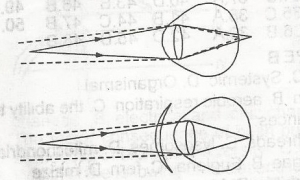
In the diagram, the function of the correcting lens is to?
- A. diverge incoming rays
- B. converge incoming rays
- C. reflect incoming rays
- D. screen incoming rays
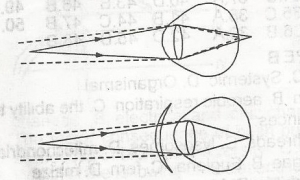
In the diagram, the eye defect illustrated is?
- A. myopia
- B. hypermetropia
- C. astigmaism
- D. cataract
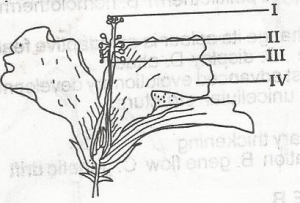
In the diagram, the likely pollinating agent of the flower is?
- A. wind
- B. water
- C. insect
- D. man
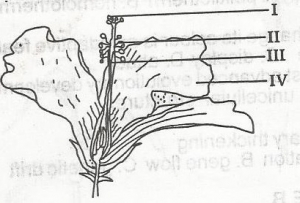
In the diagram, the male sex cells are contained in the part labelled?
- A. i
- B. ii
- C. iii
- D. iv
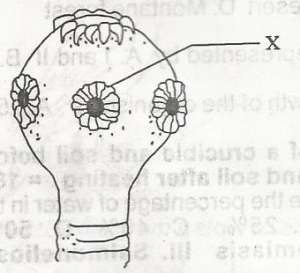
In the diagram, the habitat of the organism is
- A. slow moving streams and marshes
- B. the stomach of large mammals
- C. under leaf filter on forest floor
- D. the small intestine of large vertebrates
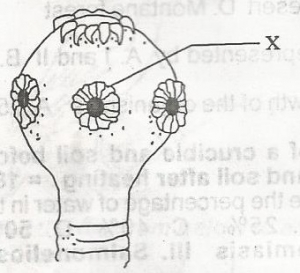
In the diagram, the structure labelled X is for?
- A. attachment
- B. feeding
- C. seeing
- D. breathing
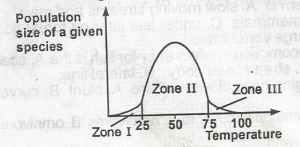
Use the diagram above to answer this question.
The optimum temperature for the growth of the organism is
- A. 25oC
- B. 50oC
- C. 75oC
- D. 100oC
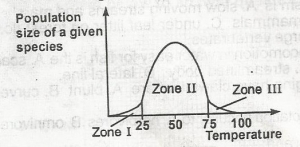
Use the diagram above to answer this question.
The zone of physiological stress is represented by?
- A. l and ll
- B. ll only
- C. ll and lll
- D. l and lll
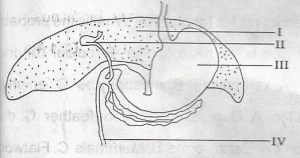
Use the diagram above to answer this question.
The content of the part labelled lll is usually?
- A. neutral
- B. alkaline
- C. acidic
- D. saline
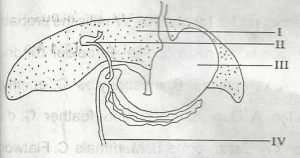
Use the diagram above to answer this question.
Emulsification of fats takes place in the part labelled?
- A. l
- B. ll
- C. lll
- D. lV
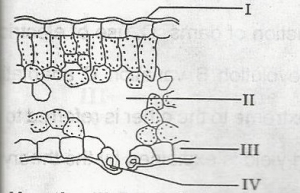
Use the diagram above to answer this question.
The part labelled l is the
- A. spongy mesophyll
- B. upper epidemis
- C. cuticle
- D. vein
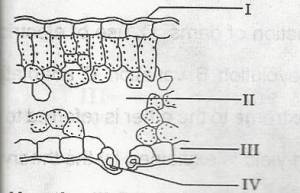
Use the diagram above to answer this question.
The structure that controls loss of water vapour during transpiration is labelled
- A. l
- B. ll
- C. lll
- D. lV
According to Darwin, the driving force behind evolutionary change is
- A. natural selection
- B. genetic drift
- C. mutation
- D. gene flow
During the dry season in the tropics, the body metabolism of some animals slow to a minimal level in a process referred to as?
- A. hibernation
- B. aestivation
- C. dormancy
- D. senescense
The specialized pigment cells that are involved in colouration and colour change in animals?
- A. xanthophyll
- B. chromatophores
- C. chlorophyll
- D. melanin
Which of the following animals is most adapted for water conservation?
- A. earthworms
- B. mammals
- C. flatworms
- D. insects
The part of a domestic fowl responsible for preventing heat loss is the?
- A. filoplume
- B. contour feather
- C. down feather
- D. quill
Plants that grow in an area that is neither too wet nor too dry are
- A. xerophytes
- B. mesophytes
- C. epiphytes
- D. hydrophytes
A health condition that is known to have resulted from gene mutation is?
- A. typhoid
- B. rabies
- C. sickle-cell anaemia
- D. sleeping sickness
A woman with the ability to roll her tongue (Tt) marries a man who cannot roll his tongue(tt). what is the probability of each of their children being a tongue roller?
- A. 100%
- B. 75%
- C. 50%
- D. 25%


